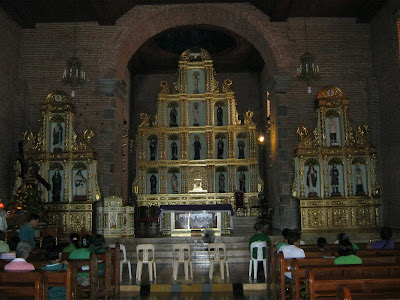
Kamay Ni Hesus Healing Center in Lucban, Quezon City
We almost didn’t have this leg of the spiritual tour.
Late in the afternoon, the group initially decided to head back to Manila from Majayjay, Laguna. However, somewhere along the way, some of the sisters I understand expressed their desire to really see this renowned place established by healing priest Fr. Joey Faller. When Bro. Steve Krueger asked me about it, I asked in return how far the place was to which he replied about 30 minutes away. I said let’s proceed. As it turned out, it was a decision we all did not regret.
From Majayjay, we passed through the municipality of Luisiana and then crossed over to the Province of Quezon. A few kilometers away from the poblacion of Lucban in Barangay Tinamnan, you will find the Kamay Ni Hesus Healing Center.

The Healing Center’s Chapel
I could only describe it as a soothing sanctuary for tired pilgrims like me. In a sense you could say that it has everything. There is a lovely chapel, a “Garden of Eden”, a Via Dolorosa Grotto of Healing, a “Way of Purification” and a 50-foot image of the “Ascending Christ”, all dedicated “to the people of the Philippines and of the whole world who believe in the Infinite Love of God.”



A sprawling 2.5 hectare ‘Garden of Eden’

The Garden featured biblical tales like the story of Creation

“Noah’s Ark” was ‘recreated’ in the Healing Center’s grounds

Famously known as Christ’s Last Supper, the scene more importantly depicts the Institution of the Holy Eucharist
Some brethren like Bro. Omin del Castillo and several others took the challenge of climbing the mountain all the way up to the image of the ‘Ascending Christ’. In my family, Faith and Joshua joined me for the climb along with niece Julia, Maymay our helper and her sister. Junior stayed behind to look after his mother and lola who found difficulty in making the uphill trek.

Jesus falls under the weight of the cross

Despite the difficult climb my children press on

By thy Holy Cross, thou has redeemed the world

Thank you Lord, we triumphantly reach the peak of this holy mountain

Spiritual reflection during the physically challenging climb is an occasion to purify one’s soul…

…while the panoramic view rejuvenates one’s weary spirit

A final picture memento before the long trek down

A close replica of Michelangelo's La Pieta

Back to Noah’s Ark

As I found out, the ‘Ark’ also known as ‘Bahay Pari’, was envisioned to be a home for old priests in the Diocese of Lucena which administers the facility. Relatively new, it was solemnly blessed by the Bishop of Lucena, the Most Reverend Emilio Marquez, D.D. along with Bishop Emeritus Ruben Profugo, D.D. only last October 27, 2010. The ‘Ark’s” facilities and amenities also make it as a suitable venue for recollections, retreats and conferences.

Faith tries out the cool and creamy ‘scramble’
If you’re hungry after all the walking and climbing, don’t fret. On the outskirts of the Healing Center’s property are numerous shops that offer food, drinks and souvenir items alike. A welcome surprise in a number of local government units particularly here in Laguna and Quezon is the prohibition on the use of plastic bags. Instead you are given brown paper bags. They’re not exactly the best container of heavy or pointed items but they are relatively more environment-friendly than most plastics.

When you’re in Lucban, don’t forget to try their chami and popular Pancit Hab-hab
One should never forget to try the native noodle products of Lucban particularly their Pancit Hab-hab. For a real authentic Lucban Pancit Hab-hab experience, try eating it the way locals traditionally do, without utensils, using only your hands to place the pancit (sometimes served over banana leaves) near your mouth.
We left Lucban still as a convoy of four (4) vehicles but took on separate routes as we reached Pagsanjan. Our vehicle took the longer western route that went through Pila, Bay, Los Baňos and Calamba, and though the SLEX tollway while the rest took the same eastern route we went through this morning back to Quezon City.
Tired but happy we reached our home sometime around midnight after bringing my in-laws to their home in Project 8. The long distances surely required endurance but also brought us a sense of new discovery, achievement and spiritual fulfillment during this time of Lent.
After all, going through the various places in a pilgrimage and marveling at God’s various creations and thanking Him for everything was already half of the deep religious experience.













































